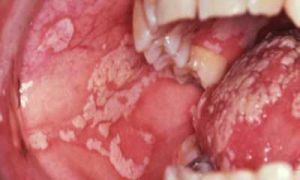 Thrush of the oral cavity( oropharyngeal candidiasis) is an infectious disease caused by fungi of the genus Candida. The pathological process manifests itself as a common or local lesion of the tongue, palatine tonsils, lips, gums, pharynx. This is the main feature of the disease.
Thrush of the oral cavity( oropharyngeal candidiasis) is an infectious disease caused by fungi of the genus Candida. The pathological process manifests itself as a common or local lesion of the tongue, palatine tonsils, lips, gums, pharynx. This is the main feature of the disease.
In the early stages of oropharyngeal candidiasis has a mild symptomatology, but without timely treatment provokes various complications.
Contents
- Prosthetic factors
- Clinical variants and symptoms
- Diagnosis and treatment
- General therapy methods
- Local effects
- Possible complications and prevention
Aggravating factors
In infants, the disease appears as a result of exogenous( external) infection from the mother or other people in contact with themat kisses, through utensils, clothes, means of hygiene).
In all adult patients, oropharyngeal candidiasis is observed with a decrease in immunity. Factors provoking endogenous reproduction of yeast-like fungi of the genus Candida are:
- deficiency of vitamins;
- bad habits( taking drugs, alcohol abuse, smoking);
- chemotherapy and radiotherapy;
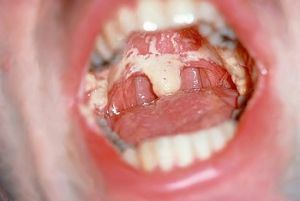
- strong stress;
- diet high in carbohydrates;
- diabetes mellitus;
- organ transplantation;
- tuberculosis;
- a long and uncontrolled intake of antibiotics, cytotoxic drugs;
- allergic manifestations;
- autoimmune pathologies( systemic lupus erythematosus, scleroderma);
- use of dentures;
- of the GI tract;
- oral contraceptive intake;
- hormone therapy.
Candidiasis of the oral cavity also develop in pregnant and lactating women, age patients with chronic diseases. Oropharyngeal candidiasis often becomes a complication of the intestinal yeast infection.
Clinical Options and Symptoms
Pathology is acute and chronic. With oropharyngeal candidiasis of an acute form, everything starts with a slight increase in temperature and a change in well-being, reminiscent of an infection of a viral or bacterial origin. After 1-2 days on the inflamed mucosa a white coating of loose consistency is formed.
The chronic form of the disease often develops when using dentures. The characteristic signs of the pathological process are burning, discomfort and dry mouth. Formed a white coating and dense in the consistency of the plaque on the inflamed mucosa. Later the raid turns into yellowish films. In the process of their removal, ulcers develop.
By the nature of the lesions, generalized and local thrush are isolated. In the first case, the whole oral cavity is affected. In the second, there are separate inflamed areas( in the tongue, lips, throat, palatine tonsils, internal surface of the cheeks, gums).
According to morphological signs oropharyngeal candidiasis is divided into pseudomembranous( more often observed in children and patients older than 60 years), atrophic, hyperplastic. The latter type of pathology is prone to malignancy.
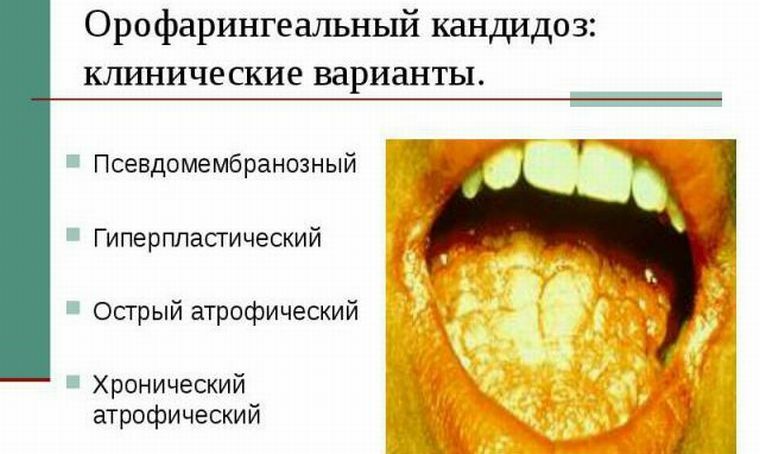
By localization, oropharyngeal candidiasis is divided into:
- Candidiasis pharyngitis at which the fungus grows actively in the pharynx. Plaque is usually white or gray.
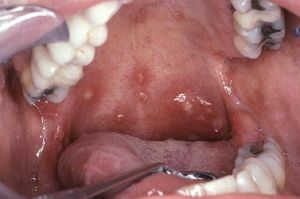 Mucous is moderately hyperemic, the temperature is slightly elevated. There is weakness and headache, burning, tingling in the throat.
Mucous is moderately hyperemic, the temperature is slightly elevated. There is weakness and headache, burning, tingling in the throat. - Halit affects the area of the lips. It manifests as peeling, cracks and the formation of solid scales on them. Also itchy, burning in the area of the lips may be disturbing. Sometimes the skin becomes cornified and compacted.
- Angular candidiasis cheilitis ( mycotic jaeda) - in the corners of the mouth red sores are formed, covered with a light coating, which is easily removed. Erosive changes can bleed, cause discomfort during eating or during a conversation.
- Fungal gingivitis affects the gums. A dirty yellow film appears on them. There is burning in the mouth, unpleasant sensations when taking acid and spicy food.
- Candida glossitis - intensive reproduction of a yeast-like fungus in the tongue. It is characterized by hyperemia of the organ, the formation of white( sometimes brown) plaque, burning, itching, hypersalivation. The patient's taste changes due to the defeat of the papillae of the tongue.
- Fungal stomatitis - appearance on the root of the tongue and under it, on the palate and inner surface of the cheeks of rashes of white color. In consistence they resemble semolina or cottage cheese, they can be of different sizes. Rashes hurt, causing discomfort during eating and during a conversation. Characterized by hyperemia and mucosal bleeding, the appearance of metallic taste in the mouth.
- Tonsillitis of the fungal nature of , which is manifested by the formation on the tonsils of curdled deposits of white color, sore throat, dysphagia. The person is disturbed by an unpleasant smell from a mouth, delicacy. Lymph nodes increase.
Diagnosis and treatment
Diagnosis usually begins with a physical examination. The specialist specifies the features of nutrition, lifestyle, the presence of long-running and family illnesses, as well as bad habits. Then blood tests( general and clinical) and microscopic examination of the scraping from the surface of the oral mucosa are prescribed. The last examination easily reveals Candida fungi.
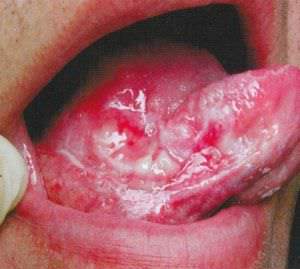
Red lichen planus has something similar to thrush
Differential diagnosis of the pathological process is carried out with syphilitic papules, red lichen planus, allergic stomatitis.
An otolaryngologist or dentist is engaged in the treatment of oropharyngeal candidiasis( depending on the location of the focus of infection).
Tactics of treatment depends on many factors: the patient's age, concomitant diseases, the method of infection, the state of immunity. Therapy can be local and general.
General therapy methods
General treatment is performed with drugs that have systemic effects on the body. Antifungal drugs are divided into 2 groups: polyene antibiotics( Levorin, Nystatin, Amphotericin) and imidazoles( Clotrimazole, Econazole).
Polyene antibiotics take from 2 to 6 times a day for about 2 weeks, imidazoles - up to 100 mg per day 1-3 weeks.
Local effects of
Local treatment with oropharyngeal candidiasis is performed with drugs that are not absorbed into the bloodstream. Effective medicines in the form of sprays, solutions, tablets( Fluconazole, ketoconazole, Natamycin).
With cheilitis, the lips are wiped with aniline dyes. Nystatin, decamine ointment, iodine preparations( Lugol's solution) are also used. 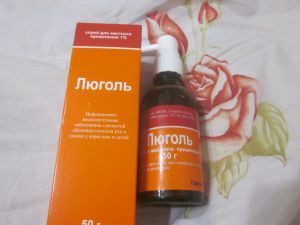
A bactericidal effect is exerted by Lysozyme, Lizak. A good result is observed from frequent( up to 6 times a day) rinsing of the oral cavity with solutions of boron, boric acid, sodium bicarbonate. When infection of the tonsils or sinuses of the nose can be prescribed physiotherapy( inhalation, quartz).
The course of treatment lasts 1-2 weeks. After the completion of therapy for another 6-7 days, it is necessary to take the recommended drugs for prevention.
For the purpose of strengthening immunity, vitamin and mineral complexes are prescribed. Calcium gluconate may be recommended. It should take about a month. To eliminate the signs of allergy caused by Candida fungi, Fenkarol, Suprastin, and Pipolphen are prescribed.
In the diet, digestible carbohydrates are limited.
Possible complications and prophylaxis of
If oropharyngeal candidiasis is not treated, the disease becomes chronic and manifests itself in acute form with reduced immunity.
It is possible to attach a secondary infection with the formation of abscesses and abscesses. In this case, you need a combination therapy( antimycotic with antibiotic), as well as the appointment of immunostimulants.
A sad result of the thrush of the oropharyngeal area can be meningitis, nephritis, endocarditis, rheumatic changes in the joints. Sometimes there is dysphagia and cachexia. However, in patients with good immune status( subject to timely treatment), the risk of complications is minimal.
To prevent the infection, it is necessary to abandon bad habits, observe the rules of oral hygiene, visit the dentist every year, balance the diet, reduce the intake of easily assimilated carbohydrates( muffins and sweets), and treat chronic diseases.
Oropharyngeal candidiasis due to the specificity of the localization is able to deliver significant discomfort and worsen the quality of life. The process is dangerous because of serious complications. However, the treatment started in time relieves the disease, and the correction of the way of life minimizes relapses.
